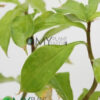- Empty cart.
- Continue Shopping
POWDERY MILDEW CAUSE AND SOLUTION

Powdery mildew is a common fungal disease that affects a wide variety of plants,
including vegetables, fruits, flowers, and ornamental plants. It appears as a white
or gray powdery coating on the leaves, stems, and flowers of plants, and can
weaken or even kill the plant if left untreated.
Causes:
Powdery mildew is caused by a group of fungi called Erysiphales, which thrive in
warm and humid conditions. The fungus can spread rapidly in environments with
poor air circulation and high humidity levels. Plants that are stressed or weakened
by drought, over-fertilization, or other environmental factors are also more
susceptible to powdery mildew.
Solutions:
Remove infected plant parts: Prune off infected leaves or stems to prevent the
fungus from spreading to other parts of the plant. Dispose of the infected plant
parts in the trash or burn them to prevent the fungus from spreading.
Increase air circulation: Good air circulation is essential for preventing powdery
mildew. Prune your plants to improve air flow and avoid planting them too closely
together. You can also use fans or open windows to increase air movement in
greenhouses or indoor growing areas.
Water properly: Avoid overwatering your plants, as excess moisture can create
ideal conditions for powdery mildew to grow. Water in the morning so that leaves
have time to dry during the day.
Use fungicides: If the above measures are not sufficient, you can use fungicides to
control powdery mildew. Look for fungicides specifically formulated for powdery
mildew and follow the instructions carefully. Organic options include neem oil,
sulfur, and potassium bicarbonate.
Preventative measures: Preventing powdery mildew is easier than treating it.
Maintain a healthy growing environment for your plants, practice good hygiene,
and monitor for early signs of the disease. This includes regularly cleaning your
gardening tools, and avoiding overhead watering if possible







